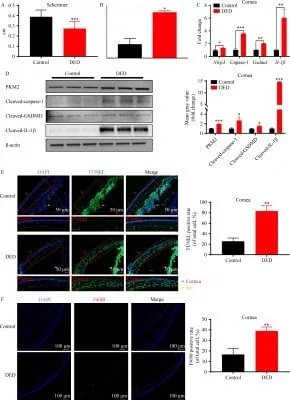
Unlocking the Mystery of Dry Eye Disease: How Hyperosmolarity Triggers Macrophage Pyroptosis
2025-09-03
Author: Wei Ling
Groundbreaking Research on Dry Eye Disease Unveiled
In an exciting revelation from researchers at the Zhejiang Provincial Engineering Institute on Eye Diseases, a recent study explores a critical link between hyperosmolarity, a key factor in dry eye disease (DED), and inflammation. Published in the prestigious 'Frontiers of Medicine,' this research could change how we understand and treat DED.
The Role of Tear Film Hyperosmolarity
Tear film hyperosmolarity disrupts the delicate balance of ocular surface homeostasis, leading to a cascade of inflammatory responses. This study dives deep into how this microenvironment affects corneal epithelial cells and subsequently triggers inflammation in nearby macrophages.
Key Findings from Clinical and Laboratory Tests
The research highlights the significant upregulation of glycolysis and pyroptosis-related genes in clinical samples from DED patients, specifically genes like PKM2 and GSDMD. Alongside these genetic changes, researchers also noted a troubling increase in the secretion of IL-1β, a cytokine that promotes inflammation.
Cellular Interactions Under the Microscope
Utilizing an innovative coculture approach, the study examined interactions between THP-1-derived macrophages and human corneal epithelial cells (HCECs). Results revealed that a hyperosmolar environment triggers metabolic reprogramming in HCECs, igniting an inflammatory response that activates macrophages.
A Potential Breakthrough: Inhibiting Glycolysis to Combat Inflammation
Researchers introduced 2-Deoxy-d-glucose (2-DG) as a glycolysis inhibitor, discovering that it could effectively suppress macrophage pyroptosis. In vivo tests further indicated that 2-DG could alleviate DED symptoms, demonstrating its ability to reduce the heightened expression of glycolysis and pyroptosis-related genes and proteins.
Conclusion: A New Perspective on Inflammation in Dry Eye Disease
This compelling research suggests that the hyperosmolar-induced glycolytic reprogramming is at the heart of DED inflammation, showcasing a pivotal mechanism that could open new avenues for treatment. Understanding these interactions not only sheds light on dry eye disease but also offers hope for millions seeking relief.


 Brasil (PT)
Brasil (PT)
 Canada (EN)
Canada (EN)
 Chile (ES)
Chile (ES)
 Česko (CS)
Česko (CS)
 대한민국 (KO)
대한민국 (KO)
 España (ES)
España (ES)
 France (FR)
France (FR)
 Hong Kong (EN)
Hong Kong (EN)
 Italia (IT)
Italia (IT)
 日本 (JA)
日本 (JA)
 Magyarország (HU)
Magyarország (HU)
 Norge (NO)
Norge (NO)
 Polska (PL)
Polska (PL)
 Schweiz (DE)
Schweiz (DE)
 Singapore (EN)
Singapore (EN)
 Sverige (SV)
Sverige (SV)
 Suomi (FI)
Suomi (FI)
 Türkiye (TR)
Türkiye (TR)
 الإمارات العربية المتحدة (AR)
الإمارات العربية المتحدة (AR)